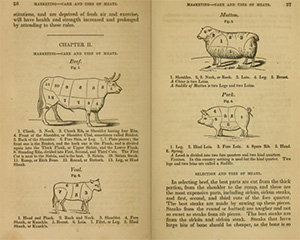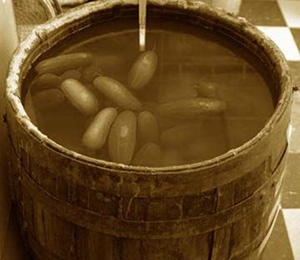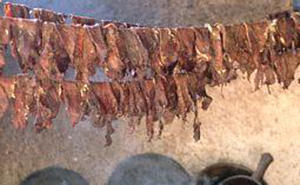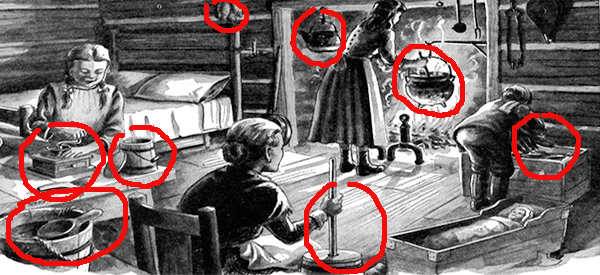When we think of the Wild West we often think of the old films with John Wayne or Clint Eastwood. They’d sit out under the stars, eating beans from a can and chewing tobacco. I grew up watching those films and I still can’t picture a cowboy without thinking of him walking cross the badlands spitting tobacco onto the sand.
But of course the Wild West of the films wasn’t quite the same as the real Wild West. The real Wild West was a very different place indeed. One of harsh conditions, lack of food and battles over land, like the Indian Wars. The frontiers people who came to the western states looking for a new life, had to be hardy folk, who had the skills to take care of themselves with little resources and scarce food availability. Many of the early arrivals came on foot, with pack horses or driving heavy-laden cows. Some even trundled their few household goods in wheelbarrows along the forest traits. Roads, over which oxen could draw covered wagons, had yet to be cleared.
In this article, we’ll look at how the frontiers folk coped with food scarcity. How they used skills like hunting, like growing and gathering vegetables and the techniques they used to preserve food during often very hard winters.
Food, Food Glorious Food
The types of food that the pioneering folk ate were dependent on two things:
- The indigenous food stuffs available
- Provisions they pick up at the point of origin (these were non-perishables like, coffee, nuts, sugar and flour)
Indigenous food: Meat
Local food was either hunted or found. Buffalo and squirrel were two of the meats that were part of the staple diet, certainly of the early settlers. In the early days of the Wild West, buffalo roamed widely and freely across the plains. There was an estimated 40 million in North America in 1830; by 1889 there were 541. The reason for the sharp decline in numbers wasn’t due to cowboys feasting on buffalo meat. No, that was down to commercial hunting. Still, buffalo was part of the diet of the early settlers because of its abundance. Buffalo hunting took two forms, ‘running’ and ‘approaching’. Running, involved great horsemanship and marksmanship. The rider would chase up against the animal on horseback and raise his gun to shot the beast as it ran alongside. Good huntsmen were known to kill 5 or 6 animals in one hunt. It was a dangerous practice, if the animal was only wounded it could potentially turn on the rider and horse. Approaching involved the type of hunting our earliest forebears would have practiced, which is stalking and using understanding and knowledge of the beast’s behavior. The hunter would use his skill and guile, using his Winchester to kill his prey. Buffalo being big beast, would provide a lot of meat for many people. The problem was the storage of the meat, we’ll explore the methods used, later on.
Other meats came straight from the forest. This included, squirrel, pigeon, rabbits, wild ducks, deer and in the far west, antelopes and elk. The latter were more difficult to hunt, as they were extremely fast and very alert.
In the early days of the Wild West, meat was abundant, but as more settlers arrived it became less so. However, this was offset by the increase in the farming of domestic animals like pigs.
Indigenous food: Vegetables
Vegetable gardening was one of the priorities of the early settlers of the Old West. Planting of a variety of vegetables, including, squash, beans, peas, sweet potatoes and potatoes, as well as onions cucumbers and melons, was part of the pioneer skill set. The Old West ‘kitchen garden’ was usually planted twice a year, much like modern vegetable patches. The spring garden would provide produce such as peas and early cabbages, whereas the late summer garden would provide food through to the early winter. This planning out of the patch was important to provide year round supplies and help avoid spoilage.
There were also plenty of wild vegetables available, such as wild onions, dandelions and dock as well as a variety of salad type leaves such as plantain. Fruits like chokeberries and huckleberries were available in places like Montana.
Corn, a staple of early West settlement, was important as a vegetable, but also for bread and biscuit making. Corn was grown from south North Dakota though to Kansas, Nebraska, south Colorado, New Mexico and Arizona and many other places.
Making the Food Last

Organized planting of kitchen gardens was one way of ensuring year round produce, but there was a real requirement to find ways of keeping food for long lengths of time, especially over winter.
Frontiers people used a variety of techniques to preserve food.
Preserving Vegetables: Pickling
Scurvy was a problem over wintertime when fresh vegetables were very scarce. Catharine Beecher was the ‘go to’ authority on methods of preserving vegetables and her book “Miss Beecher’s Domestic Receipt Book” published in 1846 offered advise and recipes for pickling vegetables (see below for an example).
Preserving Vegetables: Drying
Fruit and vegetables could be kept for extended periods by drying them out. This had to be done on a sunny day. The fruit would be prepared, often being cut into slices, then set under some light cloth (cheesecloth for example) and left out in a sunny spot. It was important not to let the fruit get too hot as this would cook it; but instead to dry it over a few days.
Preserving Meat: Salting
As soon as the animal was killed, the preparation for preserving the meat had to be made. Any meat not eaten immediately would go off quickly, especially in the summer months. The main method of preservation in the early day of the Wild West was to salt the meat. Again Catharine Beecher gave the settlers advise on how to do this (see her recipe below).
Preserving Meat: Drying
Drying meat was a recommended method for preserving beef and buffalo. Drying involved salting slices of meat, then laying the meat slices out for 2 weeks before then placing in brine for a further 3 weeks. After which the slices were dried with a cloth and hung in a cool dry place away from flies.
Preserving Meat: Smoking
This was probably the most complicated of all of the preservation techniques and involved specially prepared smoke houses. Typically, the meat would be salt cured first, sometimes using a mix of herbs for flavor. Then the meat would be hung in smoke houses over a hickory or oak based fire. The meat would hang in these smoke houses for up to a month.
Recipes That the Pioneer Used:
Pickling (the Miss Beecher way)
This recipe is taken directly from the Miss Beecher’s Domestic Receipt Book of 1846
 “PICKLES. Do not keep pickles in common earthenware, as the glazing contains lead, and combines with the vinegar. Vinegar for pickling should be sharp, but not the sharpest kind, as it injures the pickles. If you use copper, bell metal, or brass vessels for pickling, never allow the vinegar to cool in them, as it then is poisonous. Add a tablespoonful of alum and a teacup of salt to each three gallons of vinegar, and tie up a bag with pepper, gingerroot, and spices of all sorts in it, and you have vinegar prepared for any kind of common pickling. Keep pickles only in wood, or stoneware. PICKLES. Anything that has held grease will spoil pickles. Stir pickles occasionally, and if there are soft ones, take them out and scald the vinegar, and pour it hot over the pickles. Keep enough vinegar to cover them well. If it is weak, take fresh vinegar, and pour on hot. Do not boil vinegar or spice over five minutes. To Pickle Tomatoes. As you gather them, throw them into cold vinegar. When you have enough, take them out, and scald some spices tied in a bag, in good vinegar, and pour it hot over them. “
“PICKLES. Do not keep pickles in common earthenware, as the glazing contains lead, and combines with the vinegar. Vinegar for pickling should be sharp, but not the sharpest kind, as it injures the pickles. If you use copper, bell metal, or brass vessels for pickling, never allow the vinegar to cool in them, as it then is poisonous. Add a tablespoonful of alum and a teacup of salt to each three gallons of vinegar, and tie up a bag with pepper, gingerroot, and spices of all sorts in it, and you have vinegar prepared for any kind of common pickling. Keep pickles only in wood, or stoneware. PICKLES. Anything that has held grease will spoil pickles. Stir pickles occasionally, and if there are soft ones, take them out and scald the vinegar, and pour it hot over the pickles. Keep enough vinegar to cover them well. If it is weak, take fresh vinegar, and pour on hot. Do not boil vinegar or spice over five minutes. To Pickle Tomatoes. As you gather them, throw them into cold vinegar. When you have enough, take them out, and scald some spices tied in a bag, in good vinegar, and pour it hot over them. “
Beef Jerky
 Meat:
Meat:
- Beef or buffalo
Jerky brine:
Note a modern marinade would include soy sauce and molasses.
- 2 quarts water
- 1 cup salt
- ½ cup sugar
- Black pepper
- Mashed onion
Make up the brine solution, mixing all of the ingredients together.
Add the thinly sliced meat and mix through the brine solution until completely covered.
Place a plate, or similar, on top of the meat and press it down firmly onto the meat.
Leave in a cold place (ideally a refrigerator or similar) for around 8 hours.
Next rinse the brine off the meat with water and dry the meat slices with a cloth.
Air-dry the meat for an hour.
You can now add other flavorings, such as herbs or pepper.
Air-drying over several days in a hot climate was the original way jerky was made. However, safer ways include drying in a low heat oven. The oven has to be very low heat and it takes many hours for the jerky to dry out (it’s important not to let it ‘cook’). If you have a smoke house, use that, it makes great jerky.
Related: How To Preserve Beef in Glass Jars
Salting Meat
This recipe is again taken directly from the Miss Beecher’s Domestic Receipt Book of 1846
“Directions for salting down Pork.
 Cover the bottom of the barrel with salt an inch deep. Put down one layer of Pork and cover that with salt, half an inch thick. Continue thus till the barrel is full. Then pour in as much strong pickle as the barrel will receive. Always see that the Pork does not rise above the brine. When a white scum, or bloody-looking matter rises on the top, scald the brine and add more salt. Leave out bloody and lean pieces for sausages. The Pork ought to be packed as tight as possible, and always kept under the brine. Some use a stone for this purpose. In salting down a new supply, take the old brine, boil it down and remove all the scum, and then use it to pour over the Pork. “
Cover the bottom of the barrel with salt an inch deep. Put down one layer of Pork and cover that with salt, half an inch thick. Continue thus till the barrel is full. Then pour in as much strong pickle as the barrel will receive. Always see that the Pork does not rise above the brine. When a white scum, or bloody-looking matter rises on the top, scald the brine and add more salt. Leave out bloody and lean pieces for sausages. The Pork ought to be packed as tight as possible, and always kept under the brine. Some use a stone for this purpose. In salting down a new supply, take the old brine, boil it down and remove all the scum, and then use it to pour over the Pork. “
Sourdough Cornbread
 Sourdough uses the natural yeast in the air, so is a good basic bread to know how to make. You need to make a ‘starter’ for the basic bread mix. The starter is made from potatoes:
Sourdough uses the natural yeast in the air, so is a good basic bread to know how to make. You need to make a ‘starter’ for the basic bread mix. The starter is made from potatoes:
Starter
Cut 2 potatoes up into about 8 pieces and boil until tender. Take about 2 cups of the potato water. Mix into the water, 2 cups of flour and 1 tablespoon of sugar. Put the mix to one side and wait until it doubles in size.
Ingredients
1 cup of starter
Cornmeal
1 cup milk
2 tablespoons sugar
2 eggs
½ cup fat
¼ teaspoon salt
¼ teaspoon soda
Mix the starter, cornmeal, milk, sugar and beaten eggs together until well mixed. Add the fat, salt and soda. Pour the mix into a greased tin and bake for 30 minutes at about 400F.
You may also like:
This Strange Method Will Make Your Food Last For 2 Years Without Refrigeration (Video)
How to Tell When Your Canned Foods Become Spoiled?
30 Lost Ways of Survival from 1880 We Should all Learn
How to Prepare For the Coming Food Crisis























were can i get a copy of miss beechers domestic receipt book
Here: https://archive.org/stream/missbeechersdome01beec#page/n3/mode/2up
The link is also on the second photo.
I just bought my copy on Amazon.
Tap on the blue letters that tell the name of the book and the website will let you download the book for fr. Tap o the one that only says PDF.
i got mine on Barnes & Noble. I ordered it from my local store. You could probably find it on their website or on Amazon.
How much cornmeal for the sourdough cornbread?
what kind of fat do you add to this sourdough cornbread
I recommend lard as it is usually what many pioneers kept on hand and used. You can also use bacon grease if you don’t mind the added flavor.
This is a good, in depth article. I was just reading about Buffalo Bill Cody, and Generals Sheridan and Sherman, and President Grant’s concern about what they called “the Buffalo Problem.” There was quite and concerted effort to exterminate the buffalo, in order to starve the Indians into submission, with the idea that they would be forced to stay on the reservations, instead of living as they always had, wild and free, and subsisting on buffalo. We have so much to learn from all that.
My grandfather fed the starving Nez Perce from his cattle operation. He would give them whole steers to take on their way to their winter campgrounds. I have 2 pics of him greeting 2 Nez Perce women at his butchering facility.
would love to see the photos!
no one cares
Good for you and your grandfather, Izzy; I care.
I was lucky to have a good friend, Percy, the last Nez Perce medicine man, that I know of.
Your grandfather must have been a kind and caring person. Thank you for posting.
What does it mean to scald the vinegar or brine? As opposed to boiling it.
As far as i know it means bring it to a temperature just below boiling. Usually used when you want to heat something to help kill any bacteria but don’t want the flavor/texture to change or possibly do something to ruin it altogether.
heat it to just before the boiling point and a film may form on top of the vinger or brine rermove that film and throw it away
What did they do when their sugar ran out?
Usually they had long sweetening and short sweetening. Sugar can be made from many things, not just sugar cane like we modernly think of. Sugar can come from sugar beets and out west and in the midwest this was the most popular method. Sorghum grows well in the south and can be made into a pretty good sugar. Northern areas have maple syrup and other sweet sap trees. And most places have honey bees. So, with all that there is sure to be something that you can use for sugar. Most pioneers would save their white sugar for company as it was rare and a fancy thing to have out. Not to mention that back then people ate, on average, way way less sugar than modern people do now.
How did they get there own food? Did they have to grow it?
Excuse me? What History Book did you pick up the idea that Commercial Hunters as in Market Hunters killed off the herds. If you killed off the Buffalo you killed off the Plains Indian. So this was a Military Decision. They literally piled the bodies and burned them.
Thank you for the truth. They killed off the buffalo to kill off the indians.
Yes, and it’s in War Department records. One thing may have happened. It’s not quite a theory yet, but that a bacterial infection attacked the plains herds and killed more of them than hide hunters. From what I have heard about the Canadian bison, they have an on-going problem with anthrax (bacterial). It may have been that, and why anthrax was ‘common’ on settlers’ farms. Side note (and a little tongue-in-cheek). My family is staunchly Easter Woodlands. We withstood Vikings, the Portuguese who wiped out the Red Paint people, and so on. Were it not for Jews coming from Europe, we would have lost everything. We tried to warn those to the west and the Plains peoples and were laughed at. a son-in-law, a Lakota, showed what they still think, so, I told him about the Vikings and so on. And, to his anger, that when the whites hit the Plains, his people withered in only 20 years because they did not listen to those experienced. Some do listen, and as a result, liberals like Daschel (D, S. Dakota)were exposed for stealing votes from the reservations and net result was, the dnc lost a lot of elections thanks to the anger of most Lakota. Like the Cherokee sang, watch, look, and listen–always. Niio
You should check the facts before you make anecdotal comments about others. The stories that your ancestors told you are not always strictly true, as they are in the majority of the cases tainted with exaggerations and lies.
I think you guys have been playing chinese whispers for too long.
THANKS. It’s the way I grew up 70 plus years ago in central TX.
Where did the pioneers obtain vinegar, salt and the spices used ?? Assuming they brought them along, how did they replace their supply and where did they store them ??
Where did they get salt? Salt has to be processed and was expensive. The land was rich in fruits and vegetables. Timpsula (prairie turnip) was a common food on the Plains. Plums, grapes, bramble fruit, wild cherries (sand, choke, run and so on). Wild apples, pecans, walnuts, hazlenuts and so on. Mesquite was found in the valleys and valued.
Meat can be preserved by ‘air-aging’ it. This was common in drier areas. Clean and hang the carcass of a beef or deer, and wrap it to keep flies off it. You can also add smoke from damp grass and green twigs as the acid preserves food. Cooks would trim away the dried meat and use the aged meat under it. Dried meat hath its uses, of course. Small game would be preserved in tallow (after partially cooking it) or even pickled. If you like wood, then cut the meat thin and dry it in smoke. I don’t care how good you think your teeth are, you’ll need an ax to chip it small to soak to make it soft enough to chew. Marrow was cooked down for ‘butter’.
Vinegar is easy. Juice allowed to sour. Native Americans all across the continents made wine for winter use, and even brandy by allowing the wine to freeze. That, tho was strictly for the elderly 🙂 Wine and vinegar are still the best ways to preserve fruit juice to prevent scurvy and other problems. Anthropologists are still puzzled why us silly injuns tried to preserve fruit and some veggies in demijohn jars…
Easy wine or vinegar, fill a jar with fruit, flowers, or a vegetable (sweet squash is good). Mash them in the jar till the jar is half-full, then pour in boiling water to about 3/4 of the jar, and cap. Allow no air in for wine, but cap with clean rags for vinegar. Watch for mold if making vinegar and keep it clean. With chilis, we get both salsa picante and pepper relish. Both will keep on a shelf for months, if not years. Niio.
Stories like that make you wonder who the real Savages were
Don’t forget Apple Cider Vinegar: you can easily make some with just a bit of already made vinegar for a starter and apple scraps. I’ve done it. It’s easy
What did the early pioneers, explorers, and mountain men use to make coffee when they ran out of coffee beans?